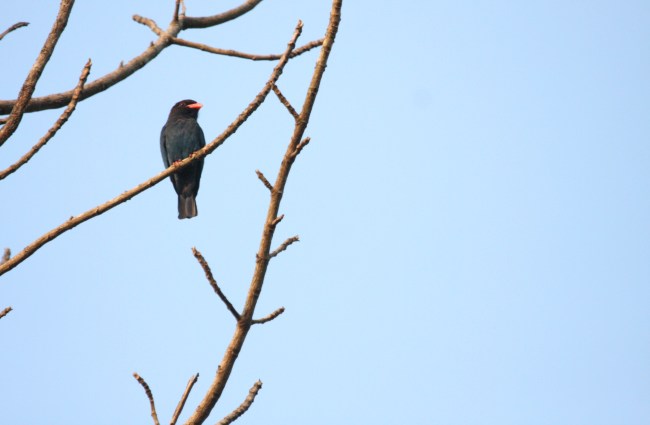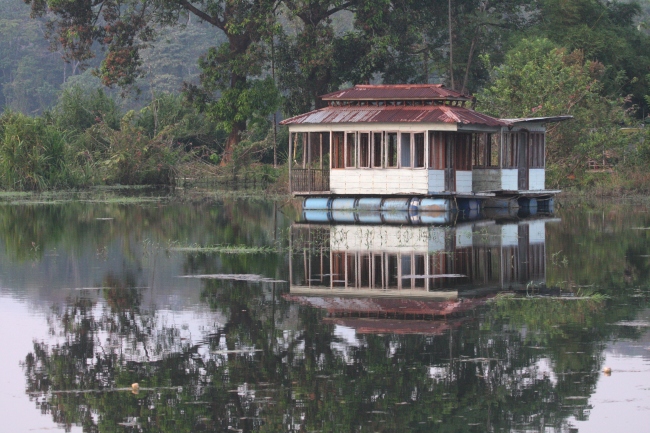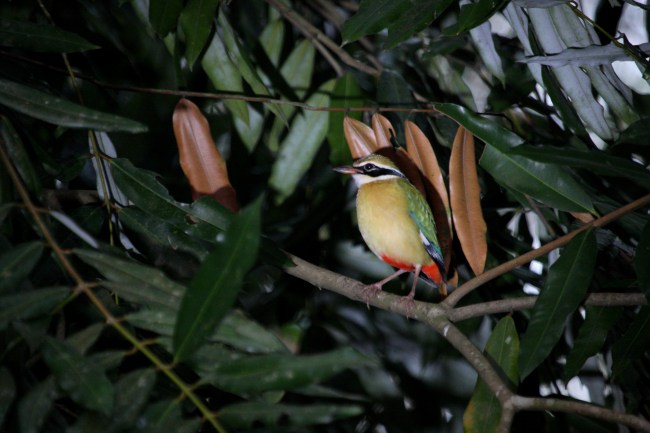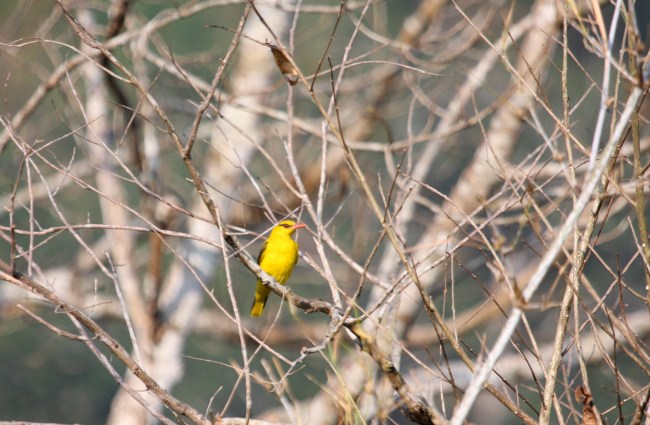Trip report: Thattekad Bird Sanctuary
Dates: 31-Jan/1-Feb 2014
Camp: Periyar River Lodge
Written: 2-Feb 2014
I’ve wanted to get to Thattekad for a while. This trip materialized unexpectedly though. Work took me to Kochi for a couple of days and I took advantage of this to spend an additional two days at Thattekad.
Thattekad
The Thattekad bird sanctuary, more precisely called the Dr. Salim Ali Bird Sanctuary lies about 80 kilometers north-east of Kochi. It comprises twenty five square kilometers of muggy, lowland evergreen forests and an astonishing number of avian species – over 280 in fact. There are also portions of riverine, scrub and dry deciduous habitats. The Periyar river and its tributaries flow through the area. The recommended window for visiting is Oct-Apr, though the season for winter migrants ends with February.
Bhoothathankettu
We’d left Kochi early in the morning and as check-in time at the Periyar River Lodge (PRL) was at noon, we had time to kill. We stopped off en route at Bhoothathankettu, 64 kilometers from Kochi, for a spot of birding. This forest falls under the Thundathil range of the Malayattoor Forest Division. In 2012, forest staff had discovered what is believed to be the largest teak tree in Asia in this range. Forty meters tall, 500 years old and 765 cms in girth, the giant remained undiscovered until then. Unfortunately I discovered this fact today, after the trip was done.
There is a trail leading off towards Old Bhoothathankettu just before the entrance to the Idamalayar Hydroelectric Project. This trail runs through some very pleasant evergreen forests for a kilometer or two until it reaches the Idamalayar, a tributary of the Periyar. Our driver Vijay was familiar with the area, blessed with superb eyesight, and was developing a fascination for learning the identities of hitherto unknown birds he’d been seeing for most of his life. This plus the time we had on our hands meant we could spend a very pleasant couple of hours on that trail, walking at the pace forests deserve to be walked through. We saw Malabar giant squirrel, Greater racket-tailed drongo, Malabar parakeet, Vernal hanging parrot, Nilgiri flycatcher, Grey headed fish eagle, Malabar whistling thrush and Orange headed thrush. Once we were done, Thattekad was but a short half hour drive from here.
Periyar River Lodge (PRL)
I hadn’t checked out the Hornbill camp, but I did see a couple of other places in Thattekad and nothing is a patch on the PRL in terms of the ambience (from what I saw). The lodge is small and cosy – just two rooms – and is built largely of teak. It is tastefully sited on the Periyar’s banks, in the midst of a rubber plantation. You could spend all day here, sitting by the river bank or reading on the porch.
Lunch done, N disappeared to nap off the fatigue of his journey leaving me to my own devices. I sat with the binos watching a pair of Red whiskered bulbuls gleaning off a tree facing the porch. Something skittered onto a slender bole fifteen feet away. It didn’t seem to be a bird or butterfly and sure enough, it was Draco dussumieri – the Southern flying lizard. I spent an engrossed ten minutes watching it skim from tree to tree. The little creature had a yellow gular sac that it folded and unfolded in a steady deliberate manner.
Once the lizard disappeared, I climbed down to the riverbank and settled down on an exposed root. A Grey junglefowl cock that had been persistently calling during lunch was now soundlessly foraging at the water’s edge on the far side. Nearer at hand, two rocky outcrops midstream held three interesting couples – a pair of Whiskered terns that occasionally took to the air on fishing forays, a much larger pair of River terns that was all squawk and little action, and an odd pair of sleeping cormorants – greater and little. The terns appeared to have a commendable strike rate, tracing large circles above the water together and steeply descending occasionally to scoop prey off the surface before returning to their place on the rock. None of the birds appeared to be bothered by the sun that blazed onto the exposed rock. And all three pairs seemed to be permanent habitués of the rock considering that I saw them on it all the time in the two days I was there.
I also had occasion to speed-read the visitors’ book in the little atrium. PRL is visited mainly by European and American tourists and unsurprisingly, they all wax eloquently about the beauty of the place and the graciousness of the hospitality.
Before I move on, I should make a mention of the open-to-air bathrooms at PRL. There is something singularly delightful about showering with a canopy of green peeping from high overhead.
While I was waiting at the Kochi airport, a friend asked me what the highlights of the trip were. After some thought, I concluded that the PRL experience was definitely one of them (the other being basking in the close presence of the frogmouth).
Gireesh
When I checked around prior to traveling, almost everyone I spoke to pointed me to Gireesh Chandran for guiding. Gireesh is a practicing lawyer aside from his near-legendary guiding credentials. He lives at the periphery of the sanctuary just off the main entrance and has eight rooms to accommodate guests who also wish to stay with him. Gireesh is a man of remarkable energy, with that equally remarkable ability to converse comfortably with you like he knew you forever. And since remarkable things come in triples, Gireesh also has a remarkable story around how he came to be a birding guide. But you should hear that from him first hand…
Being guided by Gireesh Chandran in Thattekad involves keeping up with his blistering pace of walk. Gireesh is a connoisseur of avian super-celebrities, and his single-minded purpose is to make sure you get to cover as much of the A-list as possible in the limited time you have with him. So if you’re expecting to soak in the sights and smells of the forest at leisure, stopping by every bird or other interesting sight, be forewarned that these outings aren’t going to allow you that privilege. Gireesh puts an enormous amount of effort into getting you to meet the A-listers and he expects you to do your bit by sticking with the program. He is often on the phone connecting with fellow guides and others, ceaselessly keeping track of what is sighted where.
The A-list
A quick pre-trip check revealed that the A-list for Thattekad roughly comprises: Sri Lanka frogmouth, Indian pitta, Nilgiri wood pigeon, White-bellied treepie, Nilgiri flycatcher, Grey headed bulbul, Wayanad laughing thrush, Rufous babbler, Malabar lark, Crimson backed sunbird, White-bellied blue flycatcher, Malabar parakeet, Mottled wood owl, Oriental bay owl, Oriental Scops owl, Black throated munia, Black baza, Dollar bird, Drongo cuckoo, Banded bay cuckoo and two needletails. We sighted roughly half this list.
Day 1
We did two outings, one in the evening and another the following morning. For the first one, we linked up with Gireesh in the late afternoon a few kilometers ahead of the sanctuary gate (whilst approaching from PRL). The plan was to cross into the sanctuary at a point a few kilometers north of the main gate. We were admiring a Brown breasted flycatcher prior to plunging under the fence-wire when Gireesh got a message on his “phone tree” about an Oriental bay owl having been located at another location. It was then a scramble back to the cars. This worthy had been sighted in the reserve forest adjacent to the sanctuary proper, and we veered off the dirt road (on foot) into game trails in the thick underbrush. And there in the dim understorey was our quarry – Phodilus badius – the Oriental bay owl.
Three Hungarian birdwatchers whom Gireesh was also guiding settled down to spend some time with the owl, while he took me aside to locate the Sri Lanka frogmouth. I had given Gireesh my wishlist comprising seven species – Sri Lanka frogmouth, Crimson-backed sunbird, Mottled wood owl, Oriental bay owl, Black baza, Vernal hanging parrot and Dollar bird – he was looking to get cracking right away; (Gireesh delivered five of these in two sessions plus many more bonus sightings – the elusive exceptions being the baza and the Mottled wood owl).
Sighting the Sri Lanka frogmouth – Batrachostomus moniliger – is a fairly unique experience. The bird roosts unmoving in thick undergrowth, often in the same spot for months, and at a low height. Due to its reliance on crypsis, you can creep to within a couple of meters provided you keep silent and refrain from making contact with any part of the shrubbery the bird is perched on. And once you are in position, you can spend as much time as you want staring away (or clicking); the bird continues its somnolent trance quite unmindful of you.
Owl and frogmouth done, it was back to the cars. (We had briefly stopped en route to the frogmouth for a Drongo cuckoo sighting). I had asked to be shown the quaintly named Dollar bird, and Gireesh stopped off at a point by the roadside and walked me to a pair high up on a tree.
The Hungarian trio was in quest of an obscure munia I haven’t heard of, and Gireesh led us to a still pool by the river to look for it.
While the Hungarians went about their business, N and I settled down to contemplate a circling Whiskered tern, a lone Asian openbilled stork and a number of Pond herons. Gireesh however doesn’t favour one set of his wards to the detriment of others, and it wouldn’t do to keep me hanging around waiting for a munia I’d never heard of. He therefore asked me if I’d like to meet the Stork-billed kingfisher. He then spent some considerable effort in looking for this bird, including with the lure of playback. But our luck was out and not wanting us to end the day with failure, Gireesh led us into the sanctuary via the main gate to look for the Indian pitta, leaving the Hungarians to their munia.
A few steps into the gate, he managed to spot the pitta and we spent a few minutes admiring the bird in the fading light.
The light was now gone and after stopping by his place for a quick cuppa, we headed back to the PRL in the dark, feeling that glow that accrues from a day that unfolds well.
Day 2
We met for the morning outing at the same point as the previous day, and crossed over into the sanctuary via a small gap in the (unpowered) electric fencing. Dark fronted babblers buzzed a chorus in the background. Gireesh led us up the rocky area ASK had mentioned to me earlier, to a small and lively clearing. We stood around there for a half hour. We spent another half hour on the edge of a rocky promontory nearby with a grand view of the forest below. A succession of species turned up around us in both spots.
Most numerous were Gold fronted leaf birds and Flame throated bulbuls. Malabar grey hornbills were everywhere, and their weird cackling constantly in the background on the trails as well as in the PRL. Other species sighted were the Malabar trogon, a flock of Malabar starlings, Asian fairy bluebird, Bronzed drongo, Ashy drongo, Vernal hanging parrot, Malabar parakeet, Green barbet, Golden oriole, Black headed oriole, Lesser flameback, Greater flameback, Heart spotted woodpecker, White-bellied woodpecker, Green imperial pigeon, Hill myna, Small minivet, Orange minivet, White rumped needletail, Loten’s sunbird, Crimson backed sunbird, Asian brown flycatcher, Grey tit, Grey fronted green pigeon, Crested goshawk and Banded grey cuckoo. A lone Malabar giant squirrel was also seen foraging in the forest below.
We were elated with the morning’s work, but there was more to come. We trooped to yet another spot to look at a solitary Jungle nightjar – Caprimulgus indicus – roosting on a branch high up on a tree, (the only species of nightjar that doesn’t roost on the ground).
The others in the group hadn’t seen the frogmouth, so Gireesh took us to another solitary female deep inside the underbrush. And then we were done and eager to get our breakfasts.
The canoe ride
Mr. Luige, the manager of PRL had organized a post-breakfast canoe ride up the river. Several mentions in the visitors’ book of the canoe ride’s virtues triggered our request. The “canoe” turned out to be a rather large, well-crafted wooden boat manned by two people (Eldhos of PRL and his brother). The ride was through some breathtakingly beautiful scenery. Rank vegetation and dark forests on both sides of the shallow verdant waterway. The only problem was the sun. The ride should have been done earlier in the morning, or late in the evening. As it was, a blazing sun burned down, tanning us all three shades darker. Doing this ride in the early morning or late evening would take you as close to paradise as is possible on earth.
At one spot we noticed a Malabar grey hornbill sitting on the bank. It took flight at our approach, but landed right back at the same spot. Suspecting that it was caught in a snare, we docked the boat and Vijay and I climbed up the sandy bank. The bird allowed us to approach very close, and then took flight a short distance up a tree. There was no snare and the bird was not tethered. Perhaps it was a juvenile, not fully fledged although it appeared to be adult-sized.
A fair bit of birdlife was visible on the ride. Numerous Chestnut headed bee-eaters hawked everywhere. On the trees were Asian fairy bluebird, Racket tailed drongo, a solitary Grey headed fish eagle, Malabar parakeet, Hill myna and a Little heron. In the river were cormorant, darter, River tern and the ubiquitous Whiskered terns. We spotted a solitary terrapin basking on the bank. Just before docking at the lodge, we sighted a pair of Dollar birds and a solitary White browed wagtail.
The list
Here is the full list of avian species sighted.
1/ Asian fairy bluebird
2/ Chestnut headed bee-eater
3/ Dollar bird
4/ Flame throated bulbul
5/ Red whiskered bulbul
6/ Greater cormorant
7/ Little cormorant
8/ Banded bay cuckoo
9/ Drongo cuckoo
10/ Black headed cuckoo shrike?
11/ Ashy drongo
12/ Bronzed drongo
13/ Greater racket-tailed drongo
14/ Grey headed fish eagle
15/ Lesser flameback
16/ Greater flameback
17/ Asian brown flycatcher
18/ Brown breasted flycatcher
19/ Nilgiri flycatcher
20/ Sri Lanka frogmouth
21/ Crested goshawk
22/ Malabar grey hornbill
23/ Little heron
24/ Pond heron
25/ Grey junglefowl
26/ Pied kingfisher
27/ White throated kingfisher
28/ Brahminy kite
29/ Gold fronted leaf bird
30/ Blue faced malkoha
31/ Orange minivet
32/ Small minivet
33/ Black throated munia
34/ Hill myna
35/ White-rumped needletail
36/ Jungle nightjar
37/ Asian openbilled stork
38/ Black headed oriole
39/ Golden oriole
40/ Brown hawk owl
41/ Oriental bay owl
42/ Malabar parakeet
43/ Vernal hanging parrot
44/ Green imperial pigeon
45/ Grey fronted green pigeon
46/ Indian pitta
47/ Malabar starling
48/ Crimson backed sunbird
49/ Loten’s sunbird
50/ Purple sunbird
51/ Indian swiftlet
52/ River tern
53/ Whiskered tern
54/ Malabar whistling thrush
55/ Orange headed thrush
56/ Grey tit
57/ Malabar trogon
58/ Heart spotted woodpecker
59/ White bellied woodpecker
60/ Green barbet













Congratulations on a lovely trip! Nicely written.
Thanks Ravi. You missed this, but I’ll have the pleasure of your company on the Bandipur trip I’m sure.
Great post Badri. You have a great flair for writing, keep it going.
Thank you Joe. And thank you for making the Thattekad trip happen.
Very nice blog, enjoyed reading it. Especially the tips about he bird guide, the canoe etc. are very useful for others travelling to this place. Also, the image of the Indian Pitta is very good. Thanks for sharing your experiences!
Thank you Vidya. You should try this place sometime.
Great post Badri. The post has completely made me feel that I have not missed any in the trip. Thank you for a wonderful write up.
Thank you Narayanan. For the comment and for being great company on the trip.
Dear Badri sir,
Nice sharing to your wonderful experience.awesome post.Thank you sir.
Dear Badri sir,
Nice sharing your wonderful experience.awesome post.Thank you sir.
Thank you Raja, I’m sure KMTR in Apr will be just as good or better!
Lucky, lucky Badri! Loved the photographs! The black and white of the house was specially calling out to me to come by and visit.
Thank you Janani. You should visit, you’ll love it. Btw am going back there in a couple of weekends again.
The experience is beautifully captured, Badri. Enjoyed reading it 🙂
Thank you Rekha, glad you liked it.